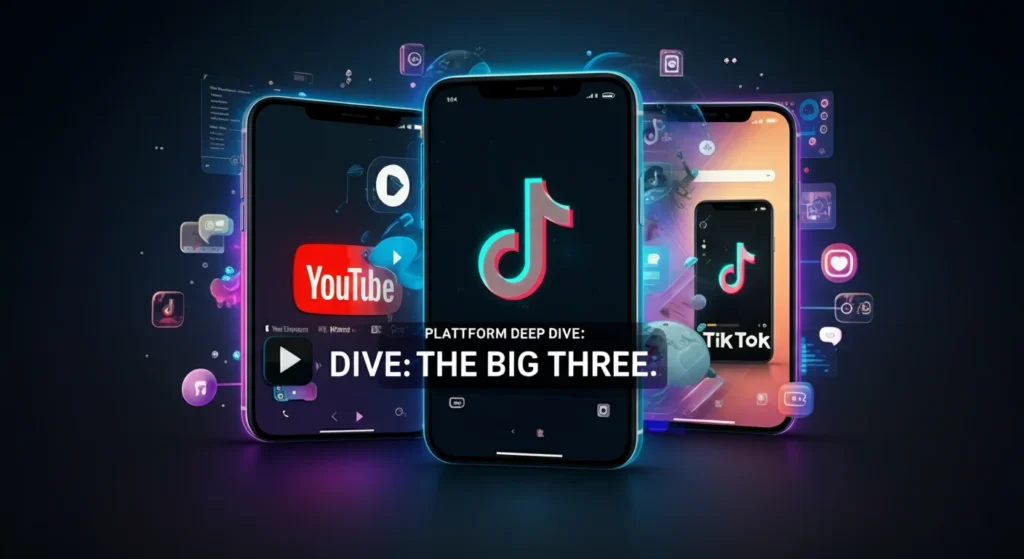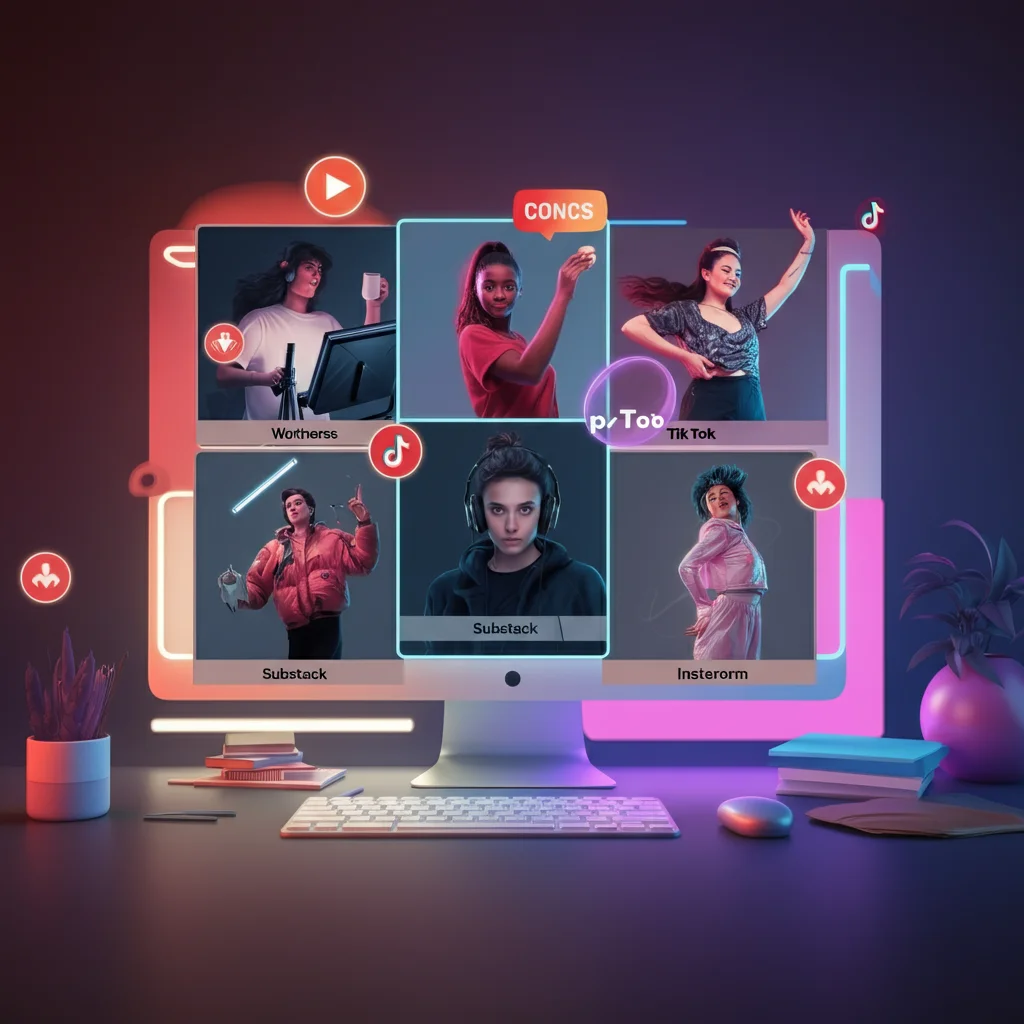The creator economy has experienced explosive growth over the past few years, with millions of individuals transforming their passions into profitable ventures. From beauty tutorials to gaming streams, content creators are changing how we consume media and build online communities.
This guide examines what is the best platform for content creation, breaking down their pros and cons to help you make an informed decision about where to invest your time and creative energy.
However, here’s the challenge: with numerous platforms available, selecting the right one can make or break your success as a creator. Each platform offers unique opportunities, monetisation methods, and audience demographics that can significantly impact your growth and earnings potential.
Whether you’re just starting your content creation journey or looking to expand to new platforms, understanding the strengths and limitations of each option is crucial. The platform you choose will influence everything from your content format to your revenue streams and community engagement.
Key Factors When Choosing Your Platform
Before diving into specific platforms, consider these essential factors that will shape your success as a content creator.
Audience Demographics
Understanding who uses each platform is fundamental to your strategy. YouTube attracts a diverse demographic across all age groups, making it ideal for a wide range of content types. Instagram skews younger, with users aged 18-34 dominating the platform, whilst TikTok captures an even younger audience, primarily Gen Z and younger Millennials.
Your content should align with your target audience’s preferences and behaviours on each platform.
Monetisation Options
Different platforms offer varying revenue streams. Some focus on advertising revenue, others prioritise brand partnerships, and emerging platforms are exploring subscription-based models. Consider both immediate earning potential and long-term monetisation strategies when evaluating platforms.
Content Format Support
Each platform excels with specific content types. Video platforms favour creators who are comfortable with filming and editing, while text-based platforms suit writers and thought leaders. Choose platforms that complement your natural content creation strengths.
Analytics and Insights
Robust analytics help you understand your audience, track performance, and optimise your content strategy. Look for platforms offering detailed insights into viewer behaviour, demographics, and engagement patterns.
Community Engagement Features
Strong community features foster deeper connections between creators and audiences. Interactive elements, such as comments, live streaming, and polls, can significantly boost engagement and loyalty.
Platform Deep Dive: The Big Three

YouTube: The Video Giant
YouTube remains the gold standard for video content creators, boasting over 2 billion logged-in users worldwide each month.
Pros:
- Massive audience reach: YouTube’s global presence offers unparalleled exposure potential.
- Diverse monetisation options: AdSense revenue, channel memberships, Super Chat, merchandise shelf, and YouTube Premium revenue provide multiple income streams
- Long-form content support: Perfect for in-depth tutorials, documentaries, and educational content
- Powerful analytics: YouTube Studio provides comprehensive insights into watch time, audience retention, traffic sources, and demographics
- Established creator economy: Successful creators like PewDiePie have built massive followings, whilst organisations like TED demonstrate the platform’s potential for educational content
Cons:
- Intense competition: With millions of creators, standing out requires exceptional content and strategy
- Complex algorithm: YouTube’s recommendation system can be unpredictable, making consistent growth challenging
- Time-intensive content creation: Quality video content requires significant time investment in filming, editing, and production
- Strict monetisation requirements: Creators need 1,000 subscribers and 4,000 watch hours to join the Partner Programme
Instagram: Visual Storytelling Hub
Instagram’s visual-first approach has made it a favourite among lifestyle, fashion, and brand-focused creators.
Pros:
- High engagement rates: Instagram consistently delivers strong interaction between creators and followers
- Visual content focus: Perfect for photography, fashion, food, and lifestyle creators
- Strong brand partnerships: Companies actively seek Instagram influencers for sponsored content
- Multiple content formats: Feed posts, Stories, Reels, and IGTV offer varied creative options
- Shopping integration: Direct product sales through posts and stories streamline the purchasing process
Cons:
- Limited monetisation options: Fewer direct revenue streams compared to YouTube
- Algorithm volatility: Frequent changes can dramatically impact reach and engagement
- Content ownership concerns: Less control over your content compared to owned platforms
- Saturated influencer market: Standing out requires consistent, high-quality visual content
Success stories like those featured in National Geographic showcase the power of visual storytelling, while Huda Beauty demonstrates effective brand building and influencer marketing.
TikTok: The Viral Sensation
TikTok has revolutionised short-form content, offering unprecedented viral potential for creators.
Pros:
- Explosive viral potential: TikTok’s algorithm can propel unknown creators to millions of views overnight
- Young, engaged audience: Access to Gen Z consumers who are highly active and responsive
- Easy content creation: Simple editing tools make content production accessible to beginners
- Trend-driven discovery: The “For You” page algorithm promotes engaging content regardless of follower count
- Growing monetisation: Creator Fund, brand partnerships, live gifts, and shopping features are expanding
Cons:
- Short-form limitations: 60-second to 10-minute videos may not suit all content types
- Algorithm unpredictability: Viral success can be inconsistent and difficult to replicate
- Limited monetisation maturity: Fewer established revenue streams compared to older platforms
- Content lifespan: Trends move quickly, requiring constant content creation to maintain relevance
Charli D’Amelio exemplifies TikTok’s viral potential, whilst The Washington Post shows how established organisations can leverage the platform for educational content.
Emerging Platforms Worth Considering

Twitch: Live Streaming Powerhouse
Twitch dominates the live streaming space, particularly for gaming content, but has expanded to include “Just Chatting,” creative content, and educational streams.
Pros:
- Real-time audience interaction through chat
- Strong monetisation through subscriptions, donations, and sponsorships
- Dedicated, engaged gaming and creative communities
Cons:
- Requires consistent streaming schedules
- Limited content discoverability compared to algorithmic platforms
- Primarily appeals to specific niches
Patreon: Subscription-Based Support
Patreon enables creators to build sustainable income through subscriber support rather than relying solely on advertising or brand partnerships.
Pros:
- Predictable monthly income from supporters
- Direct creator-fan relationships
- Content ownership and creative freedom
Cons:
- Requires an existing audience to be effective
- The monthly subscription model may limit casual viewers
- The platform takes a percentage of earnings
Making Your Choice
Selecting the best platform for content creators depends on your unique circumstances, content style, and goals. Consider these steps:
Assess your strengths: Are you comfortable on camera? Do you excel at visual content? Are you a skilled writer? Select platforms that leverage your natural strengths.
Define your audience: Research where your target demographic spends time online. There’s no point creating content where your audience doesn’t exist.
Start with one platform: Rather than spreading yourself thin across multiple platforms initially, master one before expanding.
Consider passive income potential: Evaluate each platform’s long-term monetisation opportunities and sustainability.
Test and iterate: Experiment with different content types and posting schedules to understand what resonates with your audience.
The creator economy continues to evolve rapidly, with new platforms emerging and existing ones regularly updating their features. The best platform creators choose today might not be the same next year. Stay adaptable, closely monitor your analytics, and be prepared to pivot as the landscape evolves.
Success as a content creator isn’t just about choosing the right platform—it’s about creating valuable, engaging content that resonates with your audience, regardless of where you publish it.
FAQ About what is the best platform for content creation
What is the best platform to create content on?
There is no single “best” platform for content creation—it largely depends on your niche, audience, and content style. For example, YouTube is excellent for video-based content, offering a vast audience and strong monetisation options. Instagram and TikTok are ideal for visually engaging content, especially for niches like fashion, travel, or lifestyle. Meanwhile, blogging platforms like WordPress or Medium work well for in-depth, written pieces. It’s essential to research where your target audience spends their time and choose a platform that aligns with your content strengths and goals.
What platform pays the most for content creation?
The platform that pays the most for content creation can depend on various factors, such as the creator’s niche and audience size, but YouTube is often regarded as one of the highest-paying platforms due to its advertising revenue model and multiple monetisation options like memberships and Super Chats.
How do I choose the best platform to publish content?
Choosing the best platform involves understanding where your target audience spends most of their time, the type of content you create, and the features offered by the platform that align with your goals. It’s important to experiment and adapt as trends and platforms evolve.
Can anyone become a successful content creator?
While anyone can attempt to become a content creator, success requires consistent effort, a strong understanding of your niche and audience, creativity, and the ability to adapt to digital trends. Building an audience takes time and dedication.


